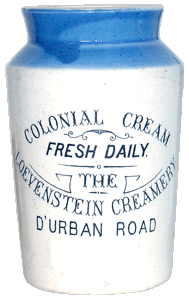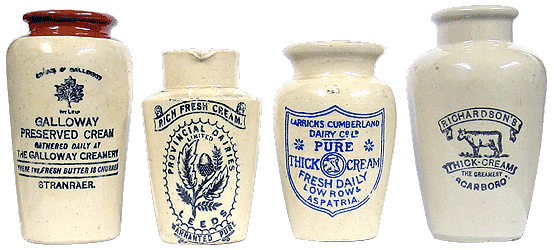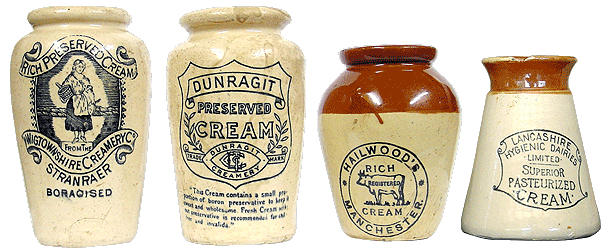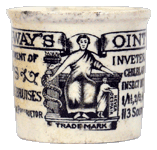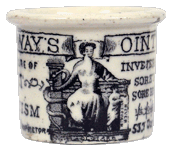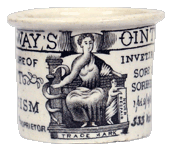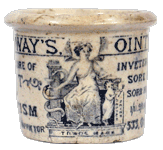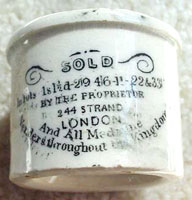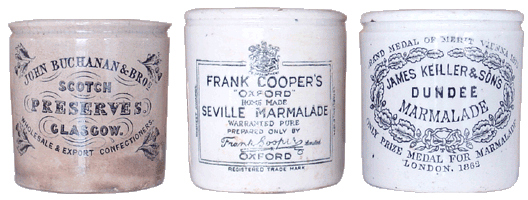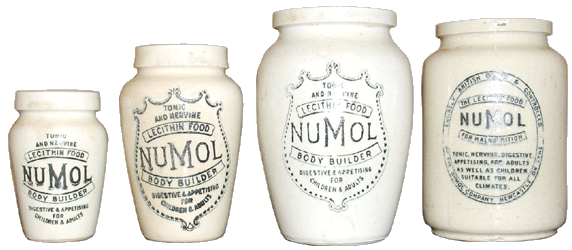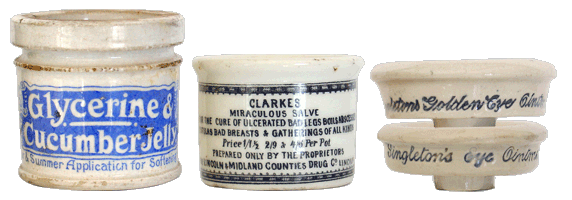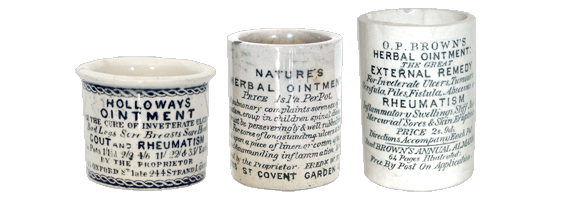Printed Pots and Jars would have contained various commodities including ointment, mustard, cream, cheese, meats, Anchovy Paste or any other cammodities which were worthy of such extravagant packaging. These are amongst the most decorative and hence, collectable items which one may come across on a dig. Arsenate of Lead Aresenate of lead was used, to quote the label
on the above McDougall's pot "on fruit trees to destroy Caterpillars
and Biting Insects". It was packaged and sold in a number of
containers none more attractive than the blue printed Fergussons
with the word Poison in red which is available in a number of sizes. Bynol
Bynol was, to use the words of the manufacturer Allen & Hanbury, "A perfect combination of Malt extract and Cod Liver Oil forming a most valuable nutrient and restorative" It must have tasted bloody awful! Cheese Pots
Only the finest cheeses were packed, specially for export, in these beautiful and much sought after cheese pots. Cream (Fresh and Preserved) Pots
South Africa has only two recorded fresh cream pots. On the left is a pot from a Cape Town based dairy (not Durban, Natal as one might expect from the street address). The Loevenstein farm was located near Cape Town.
Potters mark under pot.. "Grassmarket Dairy Supply Co. Ltd. Edinburgh"
Only one of the above pots (Wigtownshire
Creamery with picture of dairy maid) was dug in South Africa. Face Cream
Boutall's Benzoin Toilet Cream / An Elegant Skin Food. (This overglazed pot is sadly starting to lose definition), La Reine Des Crémes. The Queen of Creams. A french pot containing cream prepared by Bossard Lemaire in 3 different sizes. The smallest pot would have been closed with a cork. Fish Paste
One can only surmise as to the healthiness of fish paste 100 years ago! The John Burgess & Son pot on the left of middle was the first printed pot which I ever dug up. At the bottom are two Pot Lids and an early Burgess barrel all for anchovy paste. Click on the Holloways "Boobs Out" pot for more information. Six of probably more than 20 different
and unique transfers used on Holloways ointments which cured "Cuts,
wounds, burns and bruises, inveterate ulcers, chilblains, chapped
hands, insect bites, boils, bad legs ... etc" according to
the pots addressed 113 Southwark London and "Gout and Rheumatism"
(instead of cuts, wounds, burns and bruises) in the later pots from
533 Oxford Street.
The employee who applied the transfer
to the extremely rare Holloways Pot on the left must have still been On the right is a very scarce, although plain "transitional" pot used while Holloways was moving from 244 Strand to 553 Oxford Street, London. Marmalade
Coopers and Kiellers marmalade seamed to be extremely popular judging by the large number of pots still found bearing their trademarks. Miscellaneous
Laxitive, 2 Curry Pastes, Fresh Caviar and Sarsaparilla are but a few of the many other products worthy of their own packaging during Victorian times. Mustard Pots
Mustard was a much sought after commodity at the turn of the (last) century and some mustard pots are extremely rare and valuable. Virtually all are of French origin and the two on the far right hand side were found in the Panama Canal by Dale A. Williamson. Numol
A not particularly attractive printed pot containing tonic and nervine lecithin food. Available in 3 or 4 sizes. The pot on the right is older, more scarce and carries an interesting inscription "Entirely British owned & controlled" at the top of the oval label. Ointment
THE STAR / CARBOLIC / OINTMENT / (LOGO)
Glycerine & Cucumber Jelly, a winter
& summer application for softening the skin. Poor Man's Friend
Probably the most commonly found printed ointment pot. Shown here are 4 different types of pot (front and rear views) The two on the right are earlier and rarer than those on the left. The instructions on usage and a list of ailments which could be cured would have been contained in a paper bill-fold wrapped around the pot. Note that this product was conveniently priced to compete with Holloways and Natures Herbal Ointment.
Virol A commonly found yet uniquely shaped
and attractive printed pot which contained a preparation of Bone
Marrow used for children and convalescing invalids.Pictured above
are six different pots most of which would have been available in
4 different sizes, the oldest on the left and the newest on the
right. |





